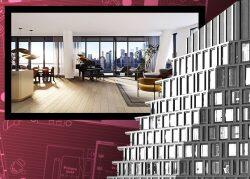Danielle Marx missed the vibrancy of Manhattan’s city streets so much that she decided to give up her Carroll Gardens condo for one in Chelsea.
When Marx, the president of a manufacturing and merchandising firm, moved to Brooklyn several years ago, she wanted more outdoor space and a breather from Manhattan’s relentless bustle. But now that she has a house in East Hampton, she’s happy to give up her outdoor space and quiet sidewalks for a pied-à-terre within walking distance of her Midtown office and in a famous art district.
“I felt like I needed to have that back in my life, the endless options that Manhattan offers us,” she said.
Marx, who’s in contract to buy a one-bedroom condo at 500 West 22nd Street where she hopes to move in early June, is far from alone. Contract signings for pieds-à-terre are up seven-fold from their pandemic low and roughly 70 percent from pre-pandemic levels, data from UrbanDigs show.
Brokers say demand is soaring for pieds-à-terre because of remote work, rising rents and a renewed joie de vivre among buyers. With the worst of the pandemic apparently behind us, more and more people want to be in New York City, at least part-time.
“A lot of people started to rethink their lives in the big picture and many of them decided ‘we want to be able to enjoy life,’” said Leonard Steinberg, corporate broker at Compass. “It’s not just the billionaires of the world dividing their time between homes.”
In the past, pieds-à-terre have been popular among wealthy financiers and high-powered executives who wanted to split their time between the city and calmer, greener pastures. Now, remote and hybrid work arrangements have opened that door to people across the income and age spectrums to live a similar lifestyle.
Steinberg said he has clients with upstate homes worth $300,000 to $400,000 who have recently taken on second residences in the city.
“I think it’s an evolution of the pied-à-terre,” he said, adding that it’s “highly unusual” for a trend to be age- and demographic-agnostic.
Read more


Data collected by UrbanDigs suggests the increase in pieds-à-terre isn’t just anecdotal. The number of contracts signed for Real Estate Board of New York listings mentioning “pied-à-terre” spiked to record highs in the second quarter of 2021, to 1,320 from a low of 177 in the first full quarter of the pandemic.
Despite the surge, the median price for those listings has remained steady at roughly $750,000. Because many co-op boards prefer having full-time residents, units in buildings that do permit part-timers are usually listed as a pied-à-terre to gain notice.
The pied-à-terre market has also been buoyed by the state legislature’s decision not to implement an extra tax on part-time residences. The proposed surcharge, which would have imposed a higher property tax on part-time residences worth a certain amount, was fervently opposed by the real estate industry two years ago before it was sidelined in favor of a higher transfer tax.
Proponents of a recurring tax tried again last year but could not gain momentum. This year the issue has barely come up in Albany, in part because the state is flush with tax revenue and federal aid.
Broadly speaking, three demographics are driving demand for pieds-à-terre: parents moving closer to their adult children, parents buying apartments for their high school- or college-aged children, and professionals. Many of the last group are bi-coastal or international workers, though foreign buyers have become more scarce.
Buyers on the higher end of the market want bigger pieds-à-terre that can serve as second homes, rather than the traditional closet-sized pad, said Pamela D’Arc, broker at Compass.
“It’s not what it used to imply, which is just a foothold,” said D’Arc, referring to the translation of the French phrase. “I think people have more cash after the pandemic than they might have had before and now they want to use it and real estate is such a good investment.”
Of course, the Manhattan condo market doesn’t only rise; it slumped for several years after peaking in the mid 2010s. But buyers typically expect home values to appreciate over the long term, as they have in the past.
Demand now is so strong that pieds-à-terre buyers are even inquiring at co-ops despite their boards’ historic resistance to part-time residents. Christopher Totaro, an agent at Coldwell Banker Warburg, said he saw a “noticeable uptick” in interest from pieds-à-terre shoppers on three co-op units he recently represented.
“Pieds-à-terre are not a slam dunk for a lot of boards,” Totaro said. “Most banks have a policy where they will not finance in a building that doesn't have a certain percentage of owner-occupied units.” A mostly empty building can find it hard to borrow to pay for repairs or to refinance debt.
Totaro added that many boards see part-time residents as having a “renter mentality” as opposed to an “owner mentality.”
While having a second home or buying a place for a recent grad might seem extravagant, buyers typically see it as a responsible investment.
“Often the people who do these things that appear extravagant are just smart,” Steinberg said.
